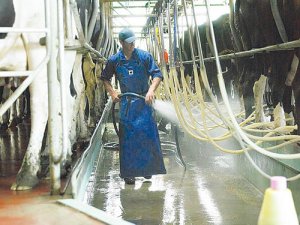Efficient processes for milk cooling, vat wash and yard hosing can add up to significant savings in water.
The following tips from DairyNZ will help identify opportunities to reduce water use and improve efficiency.
Milk cooling efficiency
• The primary milk cooling system should use about two to three times as much water as the volume of milk cooled. If there is a continuous flow of water when milk is coming through the cooler intermittently, more water is being used than necessary. To cut this water use, a solenoid valve can be installed at the inlet to the cooler and linked to the milk pump, or a variable flow drive so water and milk flow match.
• Use correct flow rates through the plate cooler – two to three litres to every litre of milk. Increasing water volume does not decrease water temperature.
• Ensure the plate cooler is serviced regularly and has adequate pumps and water storage to function efficiently. Cleaning and improving the efficiency of plate cooling will require the services of a technician who can align the plate’s spacings correctly.
• Pre-cooling water before it enters the shed can improve water use efficiency as less water is needed to cool milk.
Reducing plant and vat wash water
• Ensure all refill tanks and cylinders have an automatic shut-off to avoid overflows. Toilet cisterns or trough floats are proven as refill and shut off options.
• Consider heat exchange or pre-heating to improve energy efficiency.
• Seek advice from your detergent rep on litres required for hot/cold wash options.
• Hot water used for plant clean-up can be reused for any cleaning around the dairy shed (e.g. washing out buckets) saving electricity as well as water.
Improving yard washing efficiency
• On warm, sunny days, pre-wet the yard with a hose or sprinkler to help prevent dung from sticking.
• Use a scraper or a chain (inside an old yard hose) on the backing gate to break up dung before hosing.
• Wash the yard after each milking.
• Work the hose water actively and close to the effluent.
• Hose the yard with high water volume under low pressure so you are pushing effluent not spraying it around.
• Include a timer setting on the yard washdown pump. Set a time standard for washdown and train staff to achieve it.
• Consider capturing excess cooler water
Saving tips
Liquid ring vacuum pumps: half the water from liquid ring vacuum pumps can be recycled (as long as the temperature is less than 40°C) and half captured for yard wash. Check the manufacturer’s specifications for your pump as the temperature of the water needs to remain below specific values.
Rotaries: minimise the number of nozzles in the milking shed and consider using water blaster nozzles to reduce flows. Have smooth easy-to-clean surfaces in the dairy and use scrapers to wipe effluent off the rotary to speed up washdown. Consider air blasts or other methods such as floating plastic toys instead of water to get cows to back off.


















